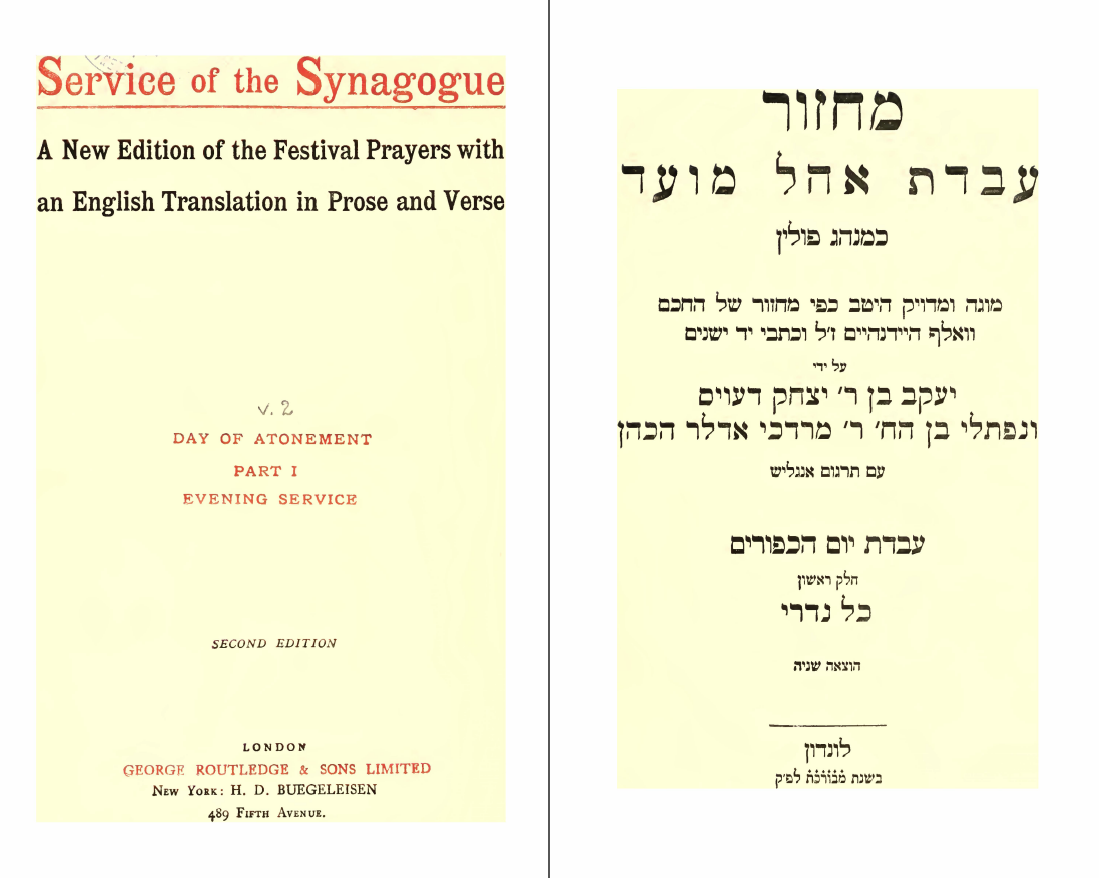
This work is in the Public Domain due to its having been published more than 95 years ago.
This work was initially scanned by the University of Toronto and uploaded to the Internet Archive. Unfortunately, this digital edition was rendered incorrectly as a left-to-right formatted book (right and left pages were flipped). Using the digital images of the resource at the Internet Archive, Aharon Varady reset the pages correctly as a right-to-left document. (Thank you!) This corrected work is now cross-posted to the Internet Archive, the digital repository for our transcription efforts.
Scanning this work is the first step in a more comprehensive project of transcribing each prayer and associating it with its translation. You are invited to participate in this project!
Concerning this set of maḥzorim, David E. Sarna writes,
“The Service for the Synagogue,” universally known as the Adler Maḥzor [or the Routledge maḥzorim -Ed.] was begun by Arthur Davis, (1846-1906), born Derby. He joined his father’s engineering business. A self-taught Hebrew scholar, he published The Hebrew Accents of the Twenty-One Books of the Bible (1892). He also began a new edition of Hebrew and English maḥzor, completed after his death by Herbert M. Adler. Davis was also the father of Elsie and Nina Davis (Mrs. Redcliffe Salaman), who translated many of the difficult liturgical poems or piyyutim into non-literal verse. The genesis of the idea for the Maḥzor was based on Solomon Schechter, had commented in one of his essays on the need for such an edition. Arthur Davis determined that it should be carried out with the greatest accuracy, both in the Hebrew text and the English version. He enjoyed the co-operation of his daughters and of Israel Zangwill who translated the poems in verse; and of another lay scholar, Herbert Adler, a lawyer nephew of the then Chief Rabbi Hermann Adler, for the prose translation.
The result of the joint enterprise was a beautifully produced, five-volume work for the Rosh HaShanah and Yom Kippur High Holidays, and one volume for each of the three major festivals, Passover, Sukkot, and Shavuot. It came out in cloth and leather editions, and was well-bound and printed on fine-quality paper.
For half a century the Adler Maḥzor was found in almost all even minimally observant Jewish homes. It was been acknowledged as the best in the English language, a worthy companion to the edition and translation of the Daily Prayer Book by the Rev. Simeon Singer.
It was reprinted in the US by the Hebrew Publishing Company and went through many printings. The Machzor had several noteworthy innovations, since widely adopted. It used a single and clean typeface, rather than a hodge-podge, and clear directions. The translation was into good English, and strives for accuracy. While today, it has been largely supplanted in most Orthodox synagogues by editions by Art Scroll (Mesorah), and others, it surely has an important place in the history of Anglo-Jewish prayer-books.

“📖 מַחֲזוֹר עֲבֹדַת אֹהֶל מוֹעֵד: עֲבֹדַת חַג הַשָּׁבֻעוֹת (אשכנז) | Maḥzor Avodat Ohel Moed: Avodat Ḥag haShavuot, arranged and translated by Arthur Davis & Herbert Adler (1909)” is shared through the Open Siddur Project with a Creative Commons Public Domain Dedication 1.0 Universal license.










Leave a Reply